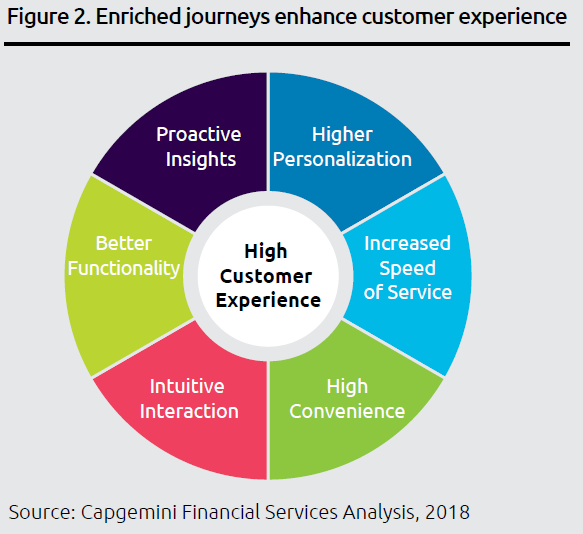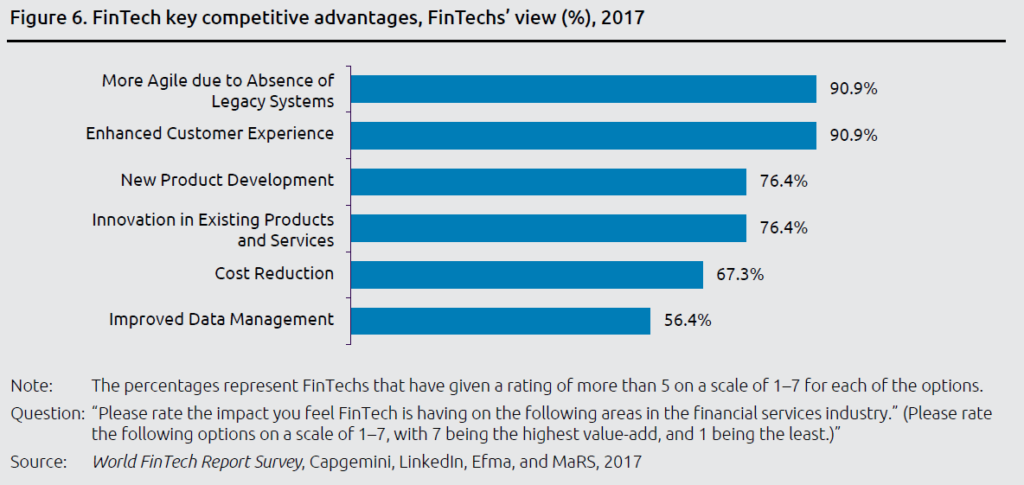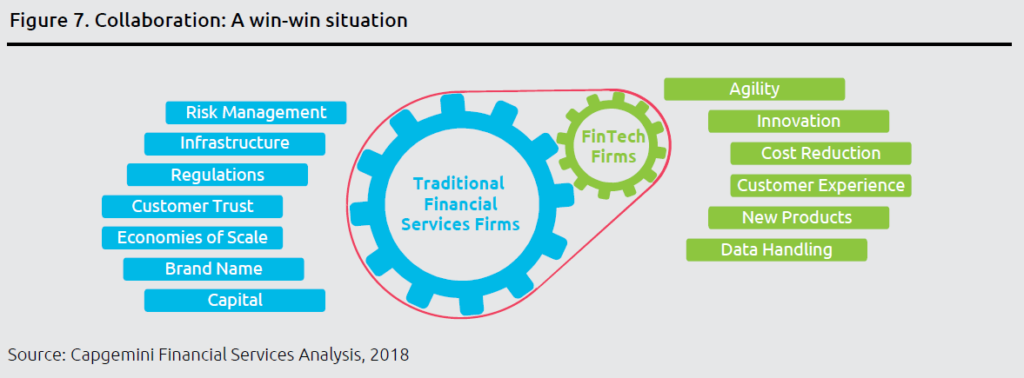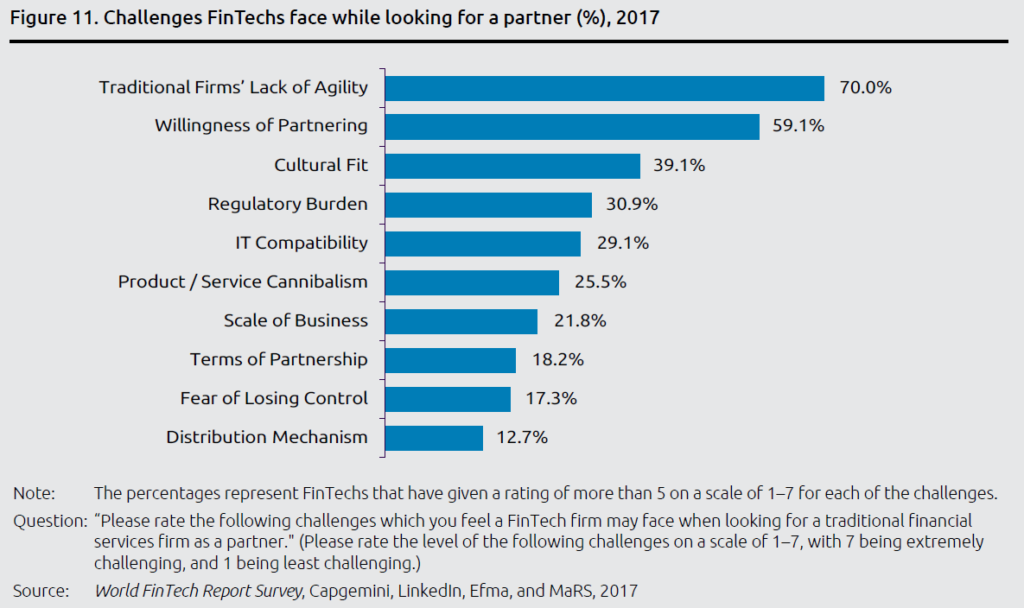
World Fintech Report 2018 – Singapore Fintech Performance
Singapore FinTech industry has been evolving in the recent years, and in 2018, Capgemini completed another global Fintech study – “World Fintech Report”, which highlights the strengths and weaknesses of FinTech and Traditional Financial Institutions. It suggests that a collaboration between the two entities would be beneficial to both sides, however there are some issues which may hinder the success of the collaboration. Singapore Fintech firms should also continue to improve and drive innovation in order to remain competitive.
With the introduction of FinTech to the financial world, FinTech firms have been able to adapt financial services to meet customers’ expectations of convenience and personalisation. This is done by following four key principles, by providing:
- a quick response,
- seamless delivery,
- relevance
- personalisation and
- building differentiated customer experiences.
The key competitive advantage that FinTech firms have over Traditional Financial Institutions, is their ability to focus on customer experience. They are also able to enjoy freedom from the burden of more stringent laws which otherwise applies to financial institutions.
Although FinTech Firms have such competitive edges over the Traditional Financial Institutions, they still face various challenges such as a lack of trust, absence of a known brand, an established distribution infrastructure, capital and regulatory compliance expertise. In which these challenges are actually the strengths of the Traditional Financial Institutions.
Due to this, these financial institutions are starting to work with, or even start up their own FinTech division, in order to fully utilise their resources, and take advantage of their strengths while enjoying the advantages that of the FinTech firms.

Paradigm shift from building or buying to collaboration
Traditionally, Financial Institutions would either build their own division, or just buy over another company which is able to provide products or services which their customers need. However, for FinTech that has since shifted to another business model, which is a collaboration between the Traditional Financial Institutions and FinTech firms.
Although some Financial Institutions still try to drive innovation within the organisation, most Financial Institutions are looking out for suitable and potential FinTech firms which they would like to collaborate with through:
- Incubators
- Accelerators
- Hackathons and
- Venture funds
It is common amongst FinTech firms to only engage in a collaboration, if it was initiated by a management level personnel from the financial institutions. Also, the vision and goals of both companies should be in line, in order for the collaboration to be a successful one.
Some of example of how traditional financial institutions are supporting Singapore Fintech:
Competition from FinTech firms pushes Financial Institutions to move towards Customer-Centricity
FinTech firms are transforming the financial services industry by raising customer expectations for convenience and personalisation, FinTech firms are motivated by the bar set by Big Tech firms such as Google, Apple, Facebook, Amazon, which drives them to provide more and better products and services which such Big Tech do not yet. FinTech firms are able to do so by utilising their strengths, such as being able to meet the increased customer expectations with agility and an improved customer journey. They are able to meet these expectations by delivering low-cost personalised products to customers which Traditional Financial Institutions were not able to provide.
FinTech firms have been able to build a strong reputation for themselves, mainly due to being able to offer products or services that are said to have a huge focus on the concept of customer centricity. They are able to offer financial services that customers require, which cannot be offered by Traditional Financial Institutions due to certain constraints on their part. Examples of such services would be:
- peer-to-peer lending
- customised solutions,
- optimal and transparent pricing.
FinTech have contributed to the financial industry by not only driving innovation through their own products and services, but also pushing traditional institutions to deliver greater customer convenience and personalized services in order to stay relevant.
One case study of the effect of such a pressure particularly from Singapore Fintech scene can be seen from DBS Bank, that have been actively coming up with new products to provide banking services to their customers with greater convenience. It is said by DBS Bank’s Sonia Wedrychowicz, Managing Director, Head of Consumer Bank Technology Singapore that “We keep customer journeys in mind throughout everything we do. That way, the customer designs the customer experience. One of our guiding principles is to look at the journey from the customer’s point of view or from outside rather than from the bank’s perspective,”.
DBS Bank has launched Singapore’s first online consumer marketplace known as “Car Marketplace”. It is created to cater to car buyers and sellers. It allows DBS Bank to eliminate the hefty fees to acquire car loan customers, whereby such fees would be later passed on to their customers. This was be done by leveraging API exchange to reach consumers directly, which would lessen the costs of acquiring customers, resulting in cheaper car loans. Such a product encourages consumers who buy and sell cars to approach the bank themselves. It is noted that this product has received a positive customer response, attracting 78,000 visitors and assisting more than 150 potential car buyers and seller In which around 45% of car buyers initiated a car loan with DBS. This is another example where traditional financial institutions in Singapore are working towards becoming more digital in this age, to compete with Singapore Fintech scene.
Competitive Edges FinTechs have over Traditional Financial Institutions
The reason for the success of FinTech firms is because of their ability to meet the expectations of their customers with agility and an improved customer journey. Here are some reasons why they were able to meet those expectations.
Agility
FinTech have the flexibility to conduct experiments of new technologies and business models, and with little constraints due to their freedom from legacy burdens, and lower cost of failure as compared to Traditional Financial institutions. FinTech firms utilises platforms that are compatible with technologies, such as cloud, artificial intelligence and DLT which allows them to quickly offer new products and services.
New Products and Services
FinTech firms creates and offers new products and services because of the agility that they enjoy which drives innovation. An example would be Slice Labs Inc. that has came up with on-demand insurance products for home-share platforms such as Airbnb, in which customers would be able to purchase insurance up to the period in which they are staying.
Enhanced Customer Experience
FinTech firms also offer enhanced customer experience by offering their solutions across platforms both online and on mobile. One example would be UK-based firm, Bud that developed a web and mobile application that aims to make various types of financial services available and easily accessible.
Innovation
Innovation is the core to the success of any FinTech firm, it is driven by an innovative culture and strong leadership support within the business. The main reason for the success of Fintech firms, is the ability to provide solutions to problems which Traditional Financial Institutions were not able to. Hence innovation is of utmost importance to these firms as it is what allows them to offer new products and services that caters to their customers’ needs.
Cost Optimisation
Fintech firms are able to achieve cost optimisation, by employing cost-effective methods such as offering their products and services online or on a mobile application. One example would be InsurTech firm Wrisk provides motor, travel, home insurance through a mobile application.
Data Management
Since FinTech firms usually operates online, on the internet, in which would most probably be compatible with data analysis tools. This makes data management important with the reason being that their businesses could collect, and utilises bytes and bytes of data to derive insights, from both structured and unstructured data collected to improve existing products or services.

Problem areas experienced by Fintech firms
Unique Value Proposition
FinTech firms are able to stand out from other firms and financial institutions, by offering a unique value proposition no other firms have been able to offer to customers. In offering a unique value proposition, smaller FinTech firms are prone to risks such as bigger companies replicating the product. In order to resolve such a problem, a unique value proposition should be hard to replicate or protected by means such as a patent.
Distribution Infrastructure
Unlike traditional financial institutions, since FinTech firms are usually new players in the financial industry, it is likely that they do not have well-established distribution networks, to make their products and services known.
Customer Trust
As FinTech is relatively new to the financial industry, it will be difficult for FinTech firms to build customer trust especially because it is less regulated. This is unlike Traditional Financial Institutions that have regulatory backing as well as established brand names.
Brand Name
Since most FinTech firms are small start-ups, they would usually not have a well-established brand name. This would require firms to put in significant time and effort as well as investments in marketing to build their brand name over time.
Regulations
Regulatory bodies across the globe have started making new regulations catered towards FinTech firms, however most FinTech firms do not have the expertise to understand and comply with the new regulations.
For example, Singapore FinTech scene is being driven and supported by the regulatory bodies through FinTech Regulatory Sandbox of MAS, whereby FinTech firms and Financial Institutions may experiment on promising innovations of products and services within a well-defined space. This support for FinTech firms would result in the increase in the number as well as quality of FinTech firms, traditional financial institutions would then be able to choose the partner that is most suitable for them.
Capital
Usually, FinTech firms have limited capital funding, in which their main source of funds would be from venture capital firms. Therefore, their operations would be affected should they not be able to create products and services that generate enough interests for venture capitalists and other investors.
This disadvantage of FinTech firms are slowly being eliminated due to governmental support, availability of resources and their proximity to financial hubs. For example, FinTech firms in countries such as London and Singapore, that are located within financial hubs, with forward-thinking governments and regulators that support FinTech are flourishing.
Government Support for Singapore Fintech Firms
Monetary Authority Singapore (MAS) has been showing a strong support for Singapore Fintech firms, from sandbox, regulatory guideline to Singapore Fintech Festival. This has help blossoms both global and Singapore Fintech scene.
Economies of Scale
FinTech firms benefit from economies of scale, by having low costs from their online operations and generating higher profits from providing solutions to their customers’ problems. However, individual FinTech firms would face challenges in customer acquisition, which would then affect profits and expansion.
Collaboration would benefit both FinTech firms and Traditional Financial Institutions
The problem areas of FinTech firms are often the strengths and advantage of Traditional Financial Institutions, this would make a collaboration advantageous to both parties. The strengths of one party can be used to complement those of the other party, and the weaknesses of one party can be eliminated by the competitive advantages of the other party.
It can be seen that banks and financial institutions are starting to see the benefits of a collaboration between them and a suitable FinTech firm. One example would be DBS Bank Singapore, where It is said by Sonia Wedrychowicz, Managing Director, Head of Consumer Bank Technology Singapore, DBS Bank that “I am a big believer in a collaboration model between banks and FinTech companies that offer ready-made customer-centric products that can be plugged into banking solutions easily and at low cost and great efficiency. At DBS we are running programs aimed not only at identifying suitable startups via hackathons, but also accelerating them or directly integrating them into our solutions. We have opened our APIs to external partners by launching the biggest API portal and sandbox in the world!”. This shows that they are willing to collaborate with FinTech firms and adopt new innovations into their business models.
Another example can be seen from “LumenLab”, which is a Singapore-based innovation centre developed by MetLife that has launched a three-month accelerator program named “Collab” that collaborates with promising InsurTech startups on areas such as innovations in customer engagement, claims, insurance business models and sales.

Importance of choosing the right partner for the collaboration
Fintech firms have expressed that the biggest challenge in a collaboration with a Traditional Financial institution, is the lack of agility and the unwillingness of the financial institutions. The reason for the unwillingness of Traditional Financial Institutions to collaborate with FinTech firms include potential problems of the collaboration having a negative impact on customer trust, brand name and also changing internal culture on the part of the Financial Institution. To overcome such challenges, it is important for both parties to clarify objectives and ensure that they share the same visions.
Effective collaboration is a long-term and evolving process, it is important for the partnering firms to understand what it takes to sustain a collaboration. It is mentioned by Sonia Wedrychowicz, Managing Director, Head of Consumer Bank Technology Singapore, DBS Bank on certain areas of concern that partnering firms should look out for. In which she said “The first rule is never incorporate a startup into the banking organisation structure, as that will kill them, Second, is always look for complementary solutions that use progressive technologies that would take years to build yourself. Third, test it and experiment with it looking for relevance and customer adoption.” This shows a strong forward thinking on how to best collaborate with global or Singapore Fintech firm.

Conclusion
Even though FinTech firms that are on the rise prove competition towards Traditional Financial Institutions. It is imperative for both entities to collaborate with each other, as both parties would benefit from the collaboration. We are seeing more collaboration between Singapore Fintech firm and traditional financier, from partnership and support through investments.
In which Traditional Financial Institutions can have access to the innovative products and services of FinTech firms. This allows them to branch out and focus more on customer centricity, as well as have less financial constraints with regards to their activities in the aspect of FinTech.
Whereas for FinTech firms, they would be able to utilise the already built brand name of the financial institution, as well as the financial resources to develop better and improved products and services. Collaborations can also help improve the Distribution network of the FinTech firms, as it grants them access to regulatory expertise, as well as increased customer trusts due to being affiliated to bigger financial institutions. This would in turn allow them to enjoy economies of scale through higher profits and decreasing costs.
Despite the advantages of a collaboration for both parties, it is important that firms are able to find the right partners for the collaboration. This is so that problems of clashing opinions and cultures do not arise, which would lead to damaging impacts on both entities.
Related Articles

Singapore Businesses Remain Positive Outlook for 2024

Unveiling the Atradius Payment Barometer 2023: Downbeat Exports Outlook Poses Challenge for B2B Trading on Credit
